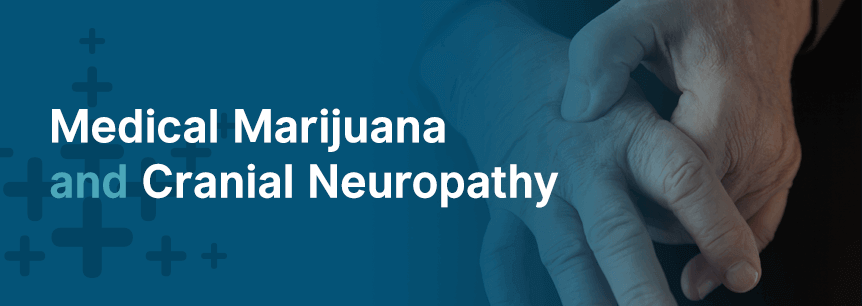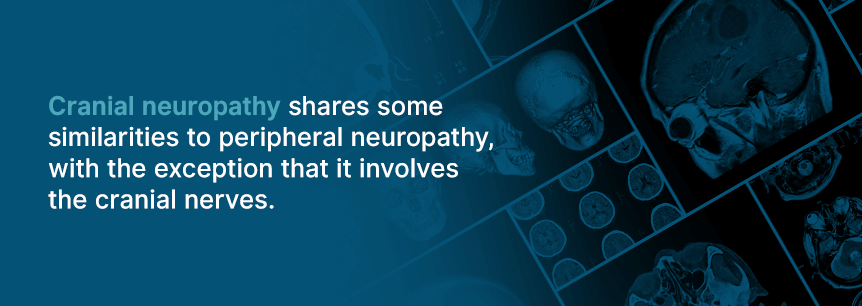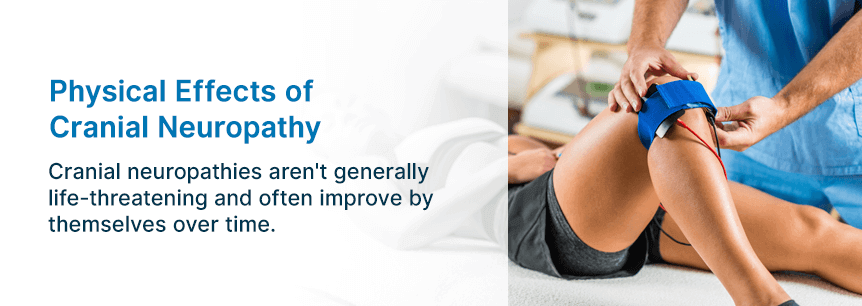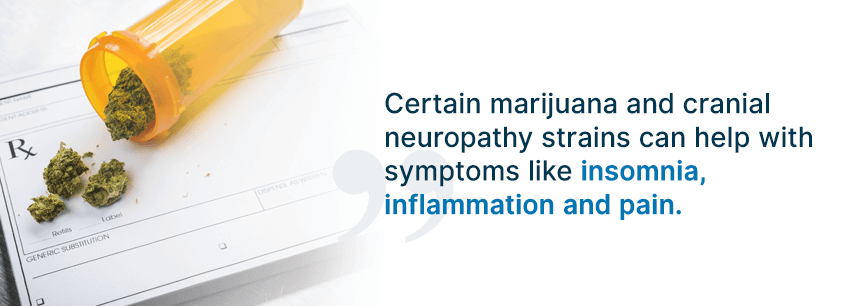
Cranial neuropathy affects many people in the U.S. Pain, weakness, numbness and other symptoms wreak havoc on patients’ quality of life. Recently, however, many individuals are trying out medical marijuana and cranial neuropathy treatment to alleviate their pain and other symptoms.
You have nerves throughout your body that power it. However, an injury or a condition such as diabetes can cause damage to these nerves. Neuropathy — which is a dysfunction in one or more of your nerves — affects how you move and feel. Exactly how it affects your movement and body depends on where the damaged nerves are in your body. However, many of the symptoms of neuropathy are the same regardless of where the neuropathy occurs.
When the damaged nerves are those in your brainstem and brain, it’s called cranial neuropathy. These cranial nerves often affect certain areas of your body, such as your eyes and face. You have 12 cranial nerves, each of which serves a different function. They are numbered with Roman numerals, from I to XII, which represent their location from front to back.
Cranial neuropathy shares some similarities to peripheral neuropathy, with the exception that it involves the cranial nerves. And, it could involve any of the 12 cranial nerves. Cranial neuropathy in individuals with diabetes usually involves the oculomotor nerve, followed by the facial and trochlear nerves in frequency order.

It’s not uncommon in the clinical practice of neurology for individuals to have multiple cranial neuropathies.
There are two specific cranial neuropathy types.
Cranial neuropathy can be referred to in a multiple cranial neuropathies (MCN) capacity, and include the following types.
To diagnose cranial neuropathy and arrive at its type, doctors perform some tests, including one or more of the following:
You can experience different symptoms depending on the type of neuropathy, and based on where the nerves are and the damage. Typically, symptoms of neuropathies include:
Symptoms of various types of cranial neuropathies may include:
There are different reasons you would develop cranial neuropathy. For instance:
A loss of blood flow to the optic nerve from the optic artery that causes ischemic optic neuropathy is a common cause of cranial neuropathy as well.
Also,
Cranial neuropathies aren’t generally life-threatening and often improve by themselves over time. However, they can affect your quality of life adversely. You need to control and manage potential causes of cranial neuropathy for you to minimize the symptoms. This is the best strategy to work and live with cranial neuropathy.

If your cranial neuropathy symptoms don’t resolve by themselves, you may need physical therapy, occupational therapy or another similar option to help manage your symptoms, boost your ability to perform certain tasks and improve your quality of life.
Neuropathic pain can be challenging to treat and is a huge factor that impacts whether or not patients experience comorbidities like depression, anxiety or poor sleep. The symptoms of cranial neuropathy symptoms can cause anxiety in people and are often a serious issue from a therapeutic and diagnostic point of view. Patients struggling with anxiety require a timely and accurate diagnosis of the underlying cause of their cranial neuropathy because of the risk of devastating neurologic conditions.
Those suffering from chronic pain often have trouble falling asleep and staying asleep. Sleep deprivation often associates with:
There’s a complex interrelationship of these factors. Many patients with chronic pain are anxious and depressed, and sleep deprivation can cause depression and anxiety.
According to the Columbia University Department of Neurology, information associated with cranial neuropathy includes:
There isn’t much information available on the natural history and incidence of neuropathy diagnosed based on electrodiagnostic and clinical criteria in people with non-insulin-dependent diabetes mellitus (NIDDM). Out of those with NIDDM, up to 7.5 percent of individuals at the time of diagnosis have clinical neuropathy. The rate goes up to 50 percent in individuals who have been struggling with diabetes for 25 years or longer.
You can’t always prevent cranial neuropathy. But, if you control the common causes of it, you can lower your risk of developing it. Many neuropathies improve over time without treatment, while other cases require permanent symptom management. Some individuals may only require physiotherapy or occupational therapy, while others may need surgery if their condition is affecting their quality of life significantly.
It’s essential for your physician to diagnose any health conditions causing your neuropathy and treating them. Treating common causes like diabetes, infections and high blood pressure can help ease your neuropathy.
If you have been determined to be deficient in vitamin B12, your physician will likely advise you to take a supplement and will provide you with the appropriate dosage.
Other things you can do to manage neuropathy are:
In some cases, medications are used for treating infection, reducing swelling near or in a nerve or helping relieve pain the neuropathy causes. Surgery might help with some types of neuropathies. Unfortunately, there are some cases where the doctor can’t treat or repair the nerve damage.
If your symptoms don’t go away by themselves, your doctor might prescribe certain medications to help bring you relief. If you have a more severe case, they may prescribe you a combination of medicines.
Medications that can help neuropathy pain are:
These may include:
Side effects of antidepressants may include:
These may include:
Side effects of anticonvulsants may include:
These may include:
Side effects of opioids may include:
These may include:
Side effects of some topical medications like Lidoderm may include:
If you’ve received a diagnosis of cranial neuropathy, speak with your doctor. They will probably tell you to call them if you experience a worsening of your symptoms or develop new ones, like vision changes, pain, weakness or numbness.
In recent years, there’s been an increased understanding of the diabetic neuropathy pathogenesis, and researchers are currently studying new medications for targeting the pathophysiological mechanisms. A couple of medications were approved recently in the U.S. for treating diabetic neuropathic pain.
As researchers begin gaining an understanding and more knowledge of the underlying pathophysiological mechanisms, symptomatic therapy is now available, and experts are exploring newer and better treatments for potentially helping with morbidity and mortality.
More than 650 clinical trials have been or are studying cranial neuropathy.

Recently, researchers discovered medical marijuana for cranial neuropathy could help individuals struggling with neuropathy by alleviating their pain related to this condition. The herb’s relationship to our endocannabinoid system is the main reason for this.
Pain sensation-detecting peripheral nerves contain cannabinoid receptors, and any consumption of cannabis can impact them. When CBD and THC enter your body, they cause CB1 and CB2 activation. They help regulate your central nervous system and your neurotransmitters, helping manage your levels of pain.
A 2010 study published in CMAJ found inhaling a single 25 mg dose of 9.4 percent THC herbal marijuana for five days, three times a day helped lower pain intensity, improved sleep and the patients tolerated it well.
Another study reported in The Journal of Pain found medical cannabis for cranial neuropathy, when compared with standard medication for neuropathic pain, was more successful at reducing pain with lower doses — 1.29 percent — versus a pain medication with a medium 3.53 percent dose.
Medical cannabis does have some small side effects, like the potential for headaches, drowsiness and increased hunger. Individuals who misuse cannabis for recreational purposes can also develop unhealthy side effects.
Marijuana for cranial neuropathy can help treat symptoms such as:
Many users of cannabis have already seen how well cannabis oil works with neuropathy.
In a study, researchers gave CBD/THC spray to 128 individuals and a placebo to 118 individuals in the study group. Those who used the marijuana spray said they had significant improvement in their levels of pain and improved sleep.
If you’re suffering from cranial neuropathy, certain marijuana and cranial neuropathy strains can help with symptoms like insomnia, inflammation, and pain. You’ll want to consult with a cannabis doctor first.

Some good strains patients have already reported work best are:
As mentioned earlier, the best way to treat cranial neuropathy is by controlling the causes and reducing the risk factors like diabetes.
Some potentially helpful strains for diabetes include:
You have numerous administration methods available to you for your cannabis treatment. Here are some popular ones for neuropathy.
If you’re thinking seriously about moving forward with medical marijuana and cranial neuropathy, you can browse our list of qualified marijuana doctors and set up an appointment for a consultation here at Marijuana Doctors. You then can look through our comprehensive directory list to find a local place where you can obtain your cannabis products.

Interact with a marijuana doctor easily from the comfort of your home through our telehealth portal system. Here you’ll discuss your treatment options and tailor up a cannabis treatment plan that’s right for you after you receive your recommendation.
Find A Doctor Find A Dispensary